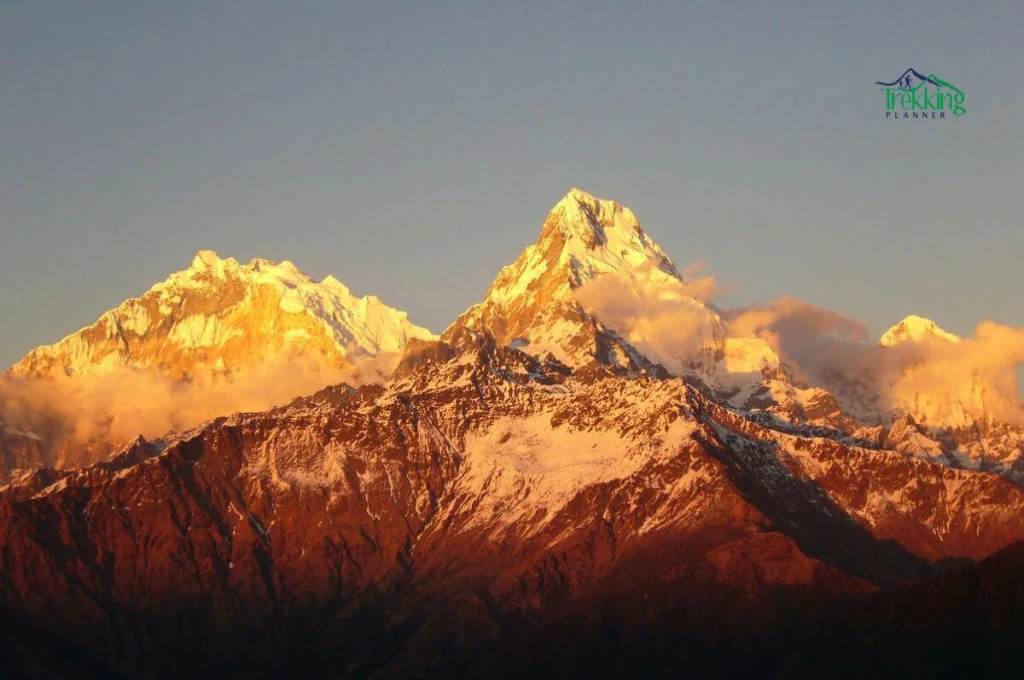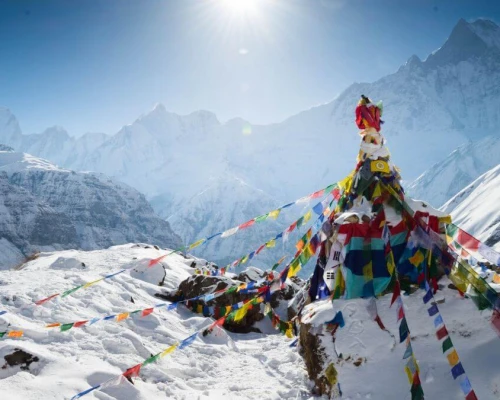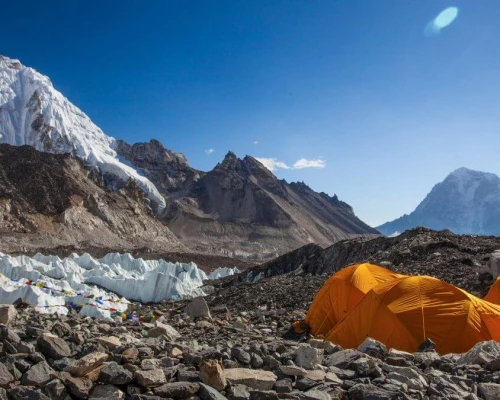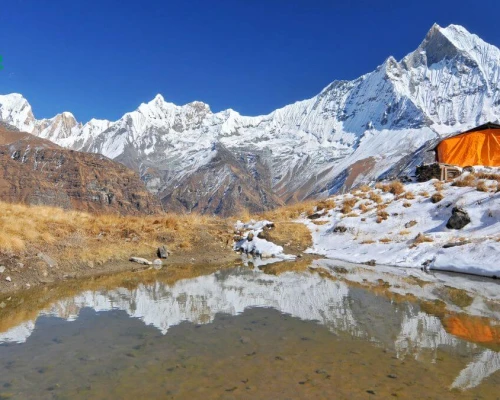North ABC Trek Difficulty and Physical Requirements
The Annapurna North Base Camp Trek is a moderate to challenging trek. Trekkers need to walk 5-7 hours daily in varied terrains, which is hard in itself. So, trekkers need a good level of physical fitness to cope with the landscape that consists of rugged terrain, steep inclines, and steep downhills. To train for the trek, trekkers need to focus on cardio training such as running, jogging, cycling, swimming, and hiking.
Similarly, trekkers need to focus on leg and core training by including squats, lunges, planks, push-ups, and pull-ups to complete the trek with ease.
You don’t need to be a professional athlete, but doing some pre-trek conditioning, such as hiking, stair climbing, or jogging, is highly advised. Trekkers should also be comfortable with basic camping since accommodation at higher altitudes is limited.
What is the Best Time to Trek to North Annapurna Base Camp?
Timing your North Annapurna Base Camp Trek is crucial to make the most of your journey. The trek offers dramatic landscapes, glacial views, and high-altitude peaks. Trekking in the right season ensures you enjoy clear skies, stable trails, and comfortable temperatures.
The best time for the North ABC Trek is spring (March to May) and autumn (September to November). Spring is marked with vibrant rhododendron blooms, which are visually appealing during the mountain adventure.
Temperatures are mild at lower altitudes, and the skies are usually clear, offering unobstructed views of Annapurna North Base Camp, Annapurna I, Gangapurna, and other surrounding peaks. Spring is an excellent time for photographers to capture natural elements, clear skies, wildlife, and snow-capped mountains.
Autumn (September to November) is the best season to travel to Annapurna North Base Camp out of all other seasons. The monsoon rains are finally over, which makes the trail green and clean. Autumn is also a festive time where people celebrate Dashain and Tihar. Traveling during this time allows one to immerse oneself in the authentic culture and tradition of the Himalayas, adding an extra layer of excitement for the tourists.
Another thing about autumn is its stable temperature, which makes walking comfortable. The crisp air flows throughout the day with clear skies, making it a perfect time for trekking activities.
Winter (December to February) is for experienced trekkers who love solitude and don’t mind the cold. Trails can be covered with snow, and higher camps require proper gear and preparation. While the North ABC Trek itinerary in winter offers unmatched quietness and pristine snowscapes, trekkers need to be prepared for temperatures that can drop well below freezing, especially near the North ABC base camp height of 4,190-4,300 meters.
The summer or monsoon season, lasting from June to August, is an off-season period for trekking. The weather is generally not recommended as there is a high chance of rainfall. The trails are slippery, and there are also risks of landslides and floods. The path can be obstructed by gloomy skies, which also generally block the mountain view. There is also an abundance of insects and leeches, which hamper the trekking experience. The forests may appear lush, but poor visibility often hides the peaks, and rivers can swell, making crossings challenging.
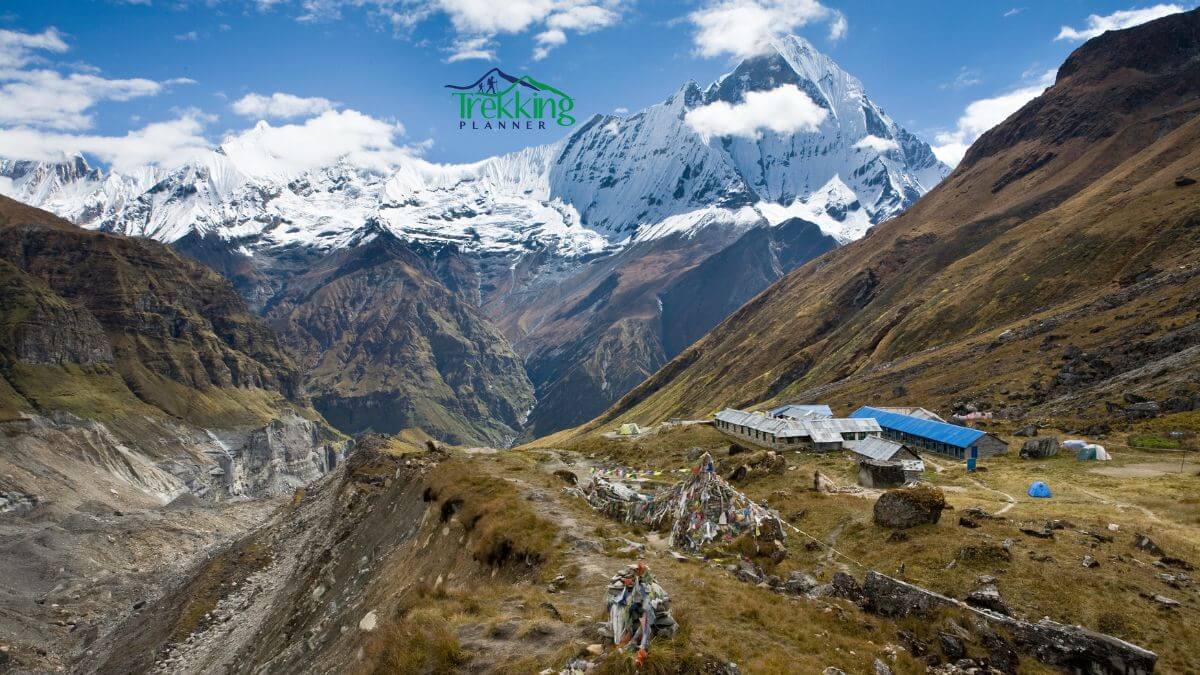
In short, if you want a mix of adventure, safety, and breathtaking mountain views, plan your trek during spring or autumn. Proper planning around these months ensures you experience the North Annapurna Base Camp Trek in its full glory, with clear views, vibrant landscapes, and a comfortable trekking experience from the starting point to the base camp.
What is the North Annapurna Base Camp Trek Cost?
The cost of the North Annapurna Base Camp Trek depends on the group size, duration, and services included. On average, expect around USD 1,100 to 1,400 per person for a complete package, including permits, guide, porter, transportation, meals, and camping equipment.
At Nepal Trekking Planner, we offer both standard and customized packages, allowing you to choose between budget-friendly camping or a fully supported trek with added comfort.
How to Reach the Starting Point?
The trek begins from Narchyang Village, about a 5-hour drive from Pokhara. From Kathmandu, you can either take a 6–7-hour drive or a 25-minute flight to Pokhara, followed by a scenic drive to Narchyang via Beni and Tatopani.
Private jeeps are available for comfortable transfers, especially when carrying camping gear and supplies.
Accommodation and Facilities During the North Annapurna Base Camp Trek
On the North Annapurna Base Camp Trek, accommodation varies depending on the altitude and remoteness of the trail. Since this trek follows a less crowded and off-beaten route, the facilities are simpler than those on the classic south-side ABC trek. Here’s what you can expect:
Lower Villages (Narchyang, Chhotepa, and nearby settlements):
- Small tea houses and guesthouses provide basic rooms with beds and blankets.
- Simple shared toilets may be available; some lodges have private toilets.
- These villages are ideal for your first night or two of trekking while you adjust to the altitude.
Mid-Altitude Campsites (Sandhikharka, small highland villages):
- Accommodation is mostly in tented camps set up by Nepal Trekking Planner.
- Camps include dining tents, sleeping tents, and toilet tents for hygiene.
- Staff ensure tents are warm, dry, and comfortable, even in windy or cold conditions.
High-Altitude Base Camp (North Annapurna Base Camp, ~4,200m):
- Permanent teahouses are scarce or nonexistent; camping is required.
- Tents are spacious and insulated to protect you from cold nights.
- Dining tents provide hot meals and a cozy place to rest after a long day’s trek.
- Other Facilities:
- Drinking water is available but usually needs to be boiled or purified.
- Electricity is limited, mainly supplied via solar panels at some campsites.
- Hot showers are rarely available; trekkers should plan to freshen up with wet wipes or cold water.
- Wi-Fi and mobile networks are very limited, especially above 3,500 meters, so this is an excellent opportunity to disconnect and enjoy the wilderness.
Even though facilities are simpler, trekking on the North ABC Trek is comfortable when traveling with an experienced trekking company. Nepal Trekking Planner provides high-quality tents, sleeping bags, and dining setups, ensuring you feel safe, warm, and well-fed throughout the journey.
What Meals are Offered During the North Annapurna Base Camp Trek?
Meals are freshly prepared by our trekking cooks, featuring a mix of Nepali and continental dishes. You can expect Dal Bhat (rice, lentils, and vegetables), soups, pasta, omelets, and seasonal fruits.
All food is hygienically cooked, and boiled water is provided for drinking. At lower altitudes, you may also try local Thakali cuisine or homemade yak cheese. Here’s a typical meal plan:
Breakfast
- Porridge or oatmeal: A warm, easy-to-digest start for cold mornings.
- Eggs: Boiled, scrambled, or omelets for protein.
- Bread, toast, or chapati: Often served with butter or jam.
- Tea, coffee, or hot chocolate: To warm you up before trekking.
- Fresh fruits: Such as apples, bananas, or seasonal local fruits when available.
Lunch
- Dal Bhat (rice and lentils): The classic Nepali trekking meal, served with vegetables and pickles.
- Pasta or noodles are often served with vegetables or light sauces for variety.
- Sandwiches or wraps: A quick, energy-boosting option during long hikes.
- Soups: Simple vegetable or noodle soups to keep you hydrated and warm.
- Energy snacks, such as biscuits, chocolate, or nuts, are often provided for trekking breaks.
Dinner
- Dal Bhat with vegetable curry and pickles: A filling, nutritious end to your day.
- Rice with lentils and meat or vegetable curry: Sometimes chicken or yak meat in higher altitudes.
- Pasta, potatoes, or porridge: For lighter meals after a long day of trekking.
- Tea or hot chocolate: To relax before bedtime.
- Fresh or dried fruits: For a healthy dessert or snack.
What are the Permits and Required Documents for North ABC Trek?
The Annapurna North Base Camp trek lies inside the Annapurna Conservation Area, which requires a permit to enter. There are government officials stationed at various checkpoints to check whether or not you have the necessary documents. If any of the licenses are missing, entry further is prohibited. The licenses and documents include:
- Annapurna Conservation Area Permit (ACAP)
- TIMS Card (Trekkers’ Information Management System)
Nepal Trekking Planner can arrange both permits before your trek begins. You’ll need to provide your passport copy, insurance details, and passport-size photos.
How to Prepare for the North Annapurna Base Camp Trek?
- Preparation is key for this trek. Start physical training at least 4-6 weeks before your departure. Focus on cardio exercises like hiking, cycling, or running to improve stamina.
- Practice walking with a backpack to get used to carrying your gear.
- Mental preparation is equally essential, embracing flexibility, patience, and the spirit of adventure since this is a remote and less-commercialized trail.
Here are some of the few training methods for coping with the North Annapurna Base Camp Trek distance and terrain:
Cardiovascular Training: Trekking to North ABC involves long days of hiking, requiring trekkers to have a solid level of cardiovascular endurance. It’s recommended that trekkers engage in cardio workouts 3-4 times weekly. Focus on strengthening the heart and lungs to improve physical capability. Additionally, consider participating in activities such as swimming, cycling, jogging, and running for cardiovascular exercise, gradually increasing both duration and intensity.
Strength Training: The North Annapurna Base Camp Trek in Nepal traverses challenging, off-road, and isolated paths in the Himalayas. The route for the North Annapurna Base Camp includes steep climbs and descents, walking on snow, narrow pathways, glacier fields, and mountain passes. To tackle such terrain, trekkers must build adequate physical strength. Therefore, trekkers should incorporate strength training into their routine once or twice a week, based on their schedules. However, this doesn’t have to involve extreme workouts, heavy lifting, or putting excessive strain on the body. Instead, trekkers should emphasize leg, core, and body exercises like squats, lunges, crunches, planks, push-ups, and sit-ups.
Weighted Backpack Training: Trekkers should practice carrying a backpack in their training, aiming to become accustomed to handling a weight of at least 7-10 kg. While it is possible to hire a porter, even carrying a day pack can feel strenuous. Items such as water, snacks, extra clothing, a camera, and personal belongings can add considerable weight. Thus, trekkers ought to practice long-distance walks while wearing a loaded backpack. Starting this training in advance is beneficial as it simulates the actual trekking experience.
Packing List for North ABC Trek
Here is a complete packing list for trekkers who are willing to do the Annapurna North Base Camp Trek:
General | - Four-season (-20 degree) sleeping bag (We provide rental sleeping bags available for an additional USD 35)
- Puffy down jacket (We provide rental jackets for an additional USD 35)
- A daypack between 25 to 30 liters should have rain protection.
|
Upper Body | - Sun hat or cap (We'll provide you with a trekking cap.)
- Warm woolen hat
- A Scarf and Neck Buff should be worn to defend against cold winds (very important for protection).
- Headlamp or mobile torch light for nighttime Polarized sunglasses
|
Torso | - Requires base layer thermals made of technical fabric which are lightweight during summer but thick for winter conditions.
- Technical fabric t-shirts and sleeve sweaters or high-necks
- Waterproof rain jacket
- Windproof jacket for the walk as it gets windy
- Fleece jacket or down jacket
|
Lower Body | - Thermals inner
- Hiking pants at least 3
- Comfortable pants for teahouses Waterproof, windproof shell
- Hiking shorts
|
Hands | - Woolen gloves for the tea house
- Hard-shell windproof outer gloves for the walk
|
Feet | - Merino Wool or comfortable, warm socks
- Hiking socks
- Liner socks
- Trekking/hiking boots (waterproof recommended)
- Crampons (For passes)
- Casual shoes or sandals that are comfortable for the time in the tea house Gaiters (lightweight for rain and snow)
|
Undergarments and inner wears | - Technical fabric/quick drying (can be washed during the trek)
- Sports bras (women)
- sleeping clothes as per the comfortability
|
First Aid Kits and Medications | - Sunscreen SPF- 50+
- Lip balm or Vaseline
- ointment cream
- Cough Syrup and Strepsils (recommended for Khumbu Cough)
- Creams and medicines (for any allergies or diseases)
|
Nepal Trekking Planner provides tents, kitchen equipment, and dining gear, so you only need to carry personal items.
Important Tips for the North Annapurna Base Camp Trek
- Always acclimatize properly; don’t rush your ascent.
- Carry snacks and energy bars for long days.
- Respect local customs and wildlife.
- Use a licensed guide and porter for safety.
- Bring a reliable waterproof jacket and gaiters, as the trail can be muddy.
- Keep your camera charged, the landscapes are spectacular!
Book the North Annapurna Base Camp Trek with Nepal Trekking Planner
The North Annapurna Base Camp Trek is an adventure that takes you off the mainstream paths into the true wilderness of the Himalayas. So, join Nepal Trekking Planner for an adventure of a lifetime. Our guides and porters are there to assist you throughout the journey for a memorable experience. We are committed to safety and eco-friendly practices. Moreover, we believe in providing an authentic Himalayan experience while immersing in the nature, culture, tradition, and customs of Nepal.
Whether you are a beginner or a seasoned trekker, the North Annapurna Base Camp trek will leave an everlasting memory. Contact us for further inquiry.


